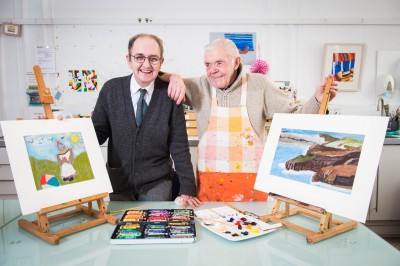- SPPC Achievements 2024-25
- Annual Conference 2025: From System Holes to Whole System
- Call for Posters
- Assisted Dying Bill - Perspectives Informed by Palliative Care
- SPPC’s response to the public consultation on the SG Strategy for Palliative Care
Exploring the importance of creative activity to palliative care
Exploring the importance of creative activity to palliative care

The successful creative arts service at The Prince & Princess of Wales Hospice is opening its doors to figures from the world of arts and heatlhcare.
To celebrate Creativity and Wellbeing Week, from June 13 to 19, the relevance of creative activity to palliative care will be explored by invited guests, from artists working within healthcare to palliative care professionals.
The idea is that the workshops, which offer guests the chance to explore different art materials and mark-making techniques, will open conversations between professionals with an interest in palliative care, arts and health.
John Jones, 54, from Govan, Glasgow, has been a day services patient at Glasgow’s Hospice since early 2015 and rediscovered a long-forgotten love for art.
“I always enjoyed art at school and my teachers wanted me to take it further but I left school and started work,” he said. “I went on to work at the Rogano restaurant, I started off as a page boy, and was then a waiter and went on to do bar work.”
He works with watercolour crayons to create bright, lively pieces of artwork, two of which hang on the walls of the hospice’s art room.
"I enjoy the peace and quiet to work in the art room, it takes your mind off other things that are going on in your life,” he added. “I look forward to going to the art room, it give you a different interest. You try not to think about what’s going on in your life and carry on as normal. The art room takes your mind off things.
“The artists are excellent, they give you help and advice. I’ve got a few pieces at home now and some on the walls of the art room.
“It is uplifting, I’d definitely recommend it. A lot of people come into the hospice and it’s not for them but many find they’re good at it and you’d think they had been drawing and painting all their lives. It just seems to come naturally.”
John Kelly, 77, from Govanhill, Glasgow enjoys painting landscapes.
“I’ve been coming to day services at the hospice every week for about six months. Staff asked me if I wanted to go to the art class and I thought I’d give it a try,” he said. “I like painting landscapes and architectural pieces. One of the first ones I did was of the monastery on the isle of Mull, it had a lot of intricate work.
“I enjoy the company in the class. I don’t get out much at home, there are things I used to do that I can’t now. The class is relaxing.”
Initially set up in 2003 to address the absence of art in palliative care in Scotland, the artists who staff the project worked from a table in the corner of day services. It has grown and thrived to become a fully integrated key service with its own art room.
The creative arts service includes visual art and creative writing workshops and is open to all patients, family members and carers registered at the hospice.
There are patient art workshops, in which individual projects are undertaken within a group, as well as private family art workshops for adults and children, a carer’s drop-in workshop, and individual patient creative writing workshops.
The service aims to give people the opportunity to develop their creativity, express themselves and try something new while engaging in a relaxing and meaningful activity during a difficult time in their life.
It gives people back some of the control they have lost through illness, disability and caring responsibilities. Unlike art therapy the intention is never to analyse or explore issues raised by the creative process.
Most people who access the creative arts service at the hospice have had no previous experience, or have been forced to give up creative pastimes through ill health. Their attendance might offer respite for the patient, family member of carer, a therapeutic activity or a focused activity with their peers.
All sessions are patient-led and supported by qualified practicing artists who have extensive experience in the arts and health, specifically in palliative care, and have ongoing art practices of their own.
“When we meet people they have often lost a lot of confidence and are going through a very difficult time. In the art room they are in charge of every mark they make. We are there to encourage and support participants to develop their own creative practice as artists in their own right, where ideas and skills can grow over time,” said artist Jeni Pearson.
“It can offer those involved an increased sense of wellbeing. Art has the ability to help us view the world through new eyes. I have heard so many of our participants say that they look at things differently now and for many it can be a life-enriching experience, and this has to be of great importance within the context of palliative care.”
The hospice is currently fundraising to build a new hospice in Glasgow’s Bellahouston Park that will offer the very latest techniques in palliative care. Art will be an integral part, with gallery space for patients’ work.
By: Angela McManus, Communications manager, Prince & Princess of Wales Hospice
Picture credit: Nick Ponty


